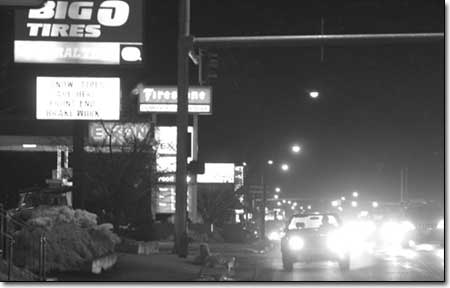|
Proposed light pollution ordinance returns to
the table
by Missy Votel
 |
| Nighttime scenes such as this
on North Main would be toned down under a Dark Skies ordinance
making its way through the city planning process. Under the
code, streetlights would have to be shielded and business
signs would be turned off at the close of business or 11 p.m.,
whichever is later./Photo by Todd Newcomer. |
After almost a year out of the public eye, the City of Durango’s
dark skies ordinance is expected to soon see the light of day.
On Wednesday evening, city planners released a second draft of
the outdoor lighting ordinance during a public meeting at the
Durango Community Recreation Center. The ordinance would decrease
nighttime light pollution, glare and trespass, or light that overflows
from one property to another, such as that of floodlights.
Unlike earlier draft versions, the latest ordinance only applies
to commercial, industrial, multi-family and public developments.
Single-family homes and duplexes would be exempt.
“It will not apply to residences,” said city planner
Millissa Berry, who was involved with drafting the ordinance.
“If you have a bare bulb on your porch, we’re not
going to make you take it down.”
However, all others will be asked to come into compliance with
the code within seven years, giving them almost three times as
long as originally discussed.
“We thought 2BD years was a little tough to meet,”
she said of the original timeframe.
Specifically, the code calls for all unshielded lights or lights
that shine upward to be capped so the light shines only downward.
It also bans roof lights; search or spot lights; mercury vapor
lighting; or any lights that flicker, blink, flash or pulse, otherwise
known as nuisance lighting. The code would not apply to holiday
lighting between Nov. 15 and Feb. 15.
“Basically, we’re just asking people to put a cap
on it so it just lights up the ground and doesn’t light
up everything else,” Berry said. “It’s not going
to be the burden people think.”
In addition to limiting the types of lighting, the ordinance
also would monitor light levels using standards and practices
of the Illuminating Engineering Society of North America.
“They’re considered to be the experts in the area,”
said Berry.
During an inventory last spring, security lighting, fast food
restaurants and convenience stores were worst violators, she said.
“A lot of fast food restaurants use their building and
lights as an attention-getter,” she said.
The code also would place restrictions on how long businesses
can keep their outdoor signs illuminated. Under the ordinance,
outdoor lighting, with the exception of security lighting, must
be turned off at the close of business or by 11 p.m., whichever
is later. They cannot be turned back on until the business opens
again in the morning or 5 a.m., whichever comes first.
Berry said in drafting the ordinance, planners looked at other
cities that already had successful dark skies ordinances, such
as Tucson, Ariz.; Bend, Ore.; and Aspen and Boulder. And while
the ordinance would be new to Durango, she said several developments
already have complied with dark skies regulations in anticipation.
“Wal-Mart, Home Depot, and Parkside Terrace are all in
compliance,” she said. “It’s already in quite
a few developments.”
Curiously enough, one entity that will face a rigorous effort
to comply is the City of Durango. The city has more than 700 unshielded
streetlights which would have to be switched out with less obtrusive
models. At the current rate of repair and replacement, which is
done by La Plata Electric Association, the conversion would be
complete in 35 years. As a result, Berry said the city and LPEA
have come up with a plan to speed up the process.
“The city and LPEA are looking for a way to cost share,”
she said. “LPEA would do the labor and the city would pay
for materials.”
Under the plan, the city would put up about $17,000 a year for
new lights and LPEA would cover the cost of installation, at about
$7,000 a year. The entire conversion would be done in seven years.
“LPEA was one of the first proponents of dark skies,”
she said. “So, they’re sympathetic to the whole thing.”
The city began looking into the possibility of a dark skies ordinance
in the summer of 2002 at the urging of concerned citizens. The
first draft of the ordinance was released in December 2002, however,
because of other pressing matters such as River Trails Ranch,
the Planning Department was not able to devote as much time to
the dark skies initiative, Berry said. However, she expects a
final draft to go before the Planning Commission in March with
the City Council voting on the ordinance in April.
|

